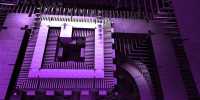In a possible boost to quantum computation and networking, a new way of regulating and manipulating single photons without producing heat has been announced by a European research collaboration. The approach enables optical switches and single-photon detectors to be integrated into a single chip.
Publishing in Nature Communications, the team reported developing an optical switch that is reconfigured with microscopic mechanical motion rather than heat, making the switch compliant with heat-sensitive single-photon detectors. Optical switches in use today operate with locally heated light guides within a semiconductor chip. “This technique does not work for quantum optics,” said co-author Samuel Gyger, a PhD student at the KTH Royal Institute of Technology in Stockholm.
Researchers develop a heat-free optical switch that would enable optical quantum computing chips. The solution makes it possible to integrate optical switches and single-photon detectors in a single chip.
“Because we want to measure a single photon, we’re using quantum detectors that operate by calculating the heat that a single photon produces when absorbed by a superconducting material,” says Gyger. “If we use conventional switches, our detectors will be saturated with heat, so they won’t function at all.”
The new approach allows the monitoring of single photons without the downside of heating up a semiconductor chip and hence renders single-photon detectors useless, says Carlos Errando Herranz, who invented the research concept and led the study at KTH as part of the European Quantum Flagship project, S2QUIP. Using microelectromechanical (MEMS) actuation, the solution allows optical switching and photon detection on a single semiconductor chip while preserving the cold temperature provided by single-photon detectors.
“Our technology will help to link all the building blocks needed for integrated optical circuits for quantum technologies,” says Errando Herranz. Quantum machines aren’t exactly the same as regular computers. They are not “stand alone” systems that run the operating system and handle keyboards and disks and CRTs and other I/O services. Instead, a quantum processing resource is a physical system that can subject quantum processes to a regulated series of operations.
“Quantum technology would allow stable message encryption and computing methods that do not solve the problems of today’s computers,” he says. “And they will include simulation resources that will enable us to understand the fundamental laws of nature that can lead to new materials and medicines.” The group will also refine the device and make it compliant with conventional electronics, which will reduce the voltages used in the experimental setup.
The task of the quantum system is to introduce the chosen quantum processes to the qubits while shielding them from unregulated interference with the setting. Eventually, you will do a “Measurement” on the tools to read the output of the computing operation that you have carried out with the series of gates.
Errando Herranz argues that the company wants to incorporate the manufacturing process into semiconductor foundries that already manufacture on-chip optics-a crucial move to make quantum optical circuits big enough to satisfy some of the promises of quantum technology.
Getting the light out of the fiber is the easiest thing to do. The hard bit is simply reading the raw signals and figuring out what the data are like. Modern devices use coherent methods to encode information in the amplitude, phase, and polarization of light-and each producer does it differently. So the greatest chance of success is to use the actual receiver from the same vendor as the transmitter. And then, you will fail as advanced devices use closed-loop feedback between the transmitter and the primary receiver, which you will not be able to take advantage of.















